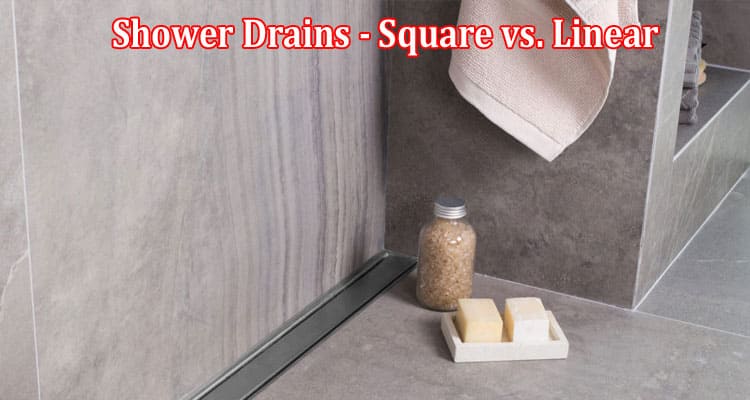Shower Drains – Square vs. Linear: Which One Suits Your Wet Room Best?
In the design of a wet room, the selection of the right shower drain is more than just a functional necessity; it’s a crucial decision that impacts the efficiency, aesthetics, and overall feel of your bathroom. A well-chosen shower drain not only effectively manages water but also complements the room’s design, blending seamlessly with the floor and enhancing the space’s visual appeal. As such, understanding the different types of shower drains and their respective benefits is key to making an informed decision.
This article focuses on a comparative analysis of the two popular types of shower drains: square and linear. Each has its own set of advantages and considerations, tailored to different styles and functional requirements. Square drains, known for their compactness and traditional appeal, have long been the standard in many homes. On the other hand, linear drains are gaining popularity for their sleek, modern look and superior drainage capabilities.
In the following sections, we will delve into the specifics of square and linear drains, discussing their design, installation, and maintenance, as well as their aesthetic impact on your wet room. By understanding the significance of each type in bathroom design, you’ll be better equipped to decide which drain suits your wet room best, ensuring a functional, stylish, and cohesive bathroom design.
Understanding Shower Drains
Shower drains are a fundamental component of any wet room, serving the crucial role of directing water away from the shower area into the waste system. This function is essential for maintaining a safe, hygienic, and comfortable bathroom environment. Beyond their practical purpose, shower drains also contribute to the overall design and feel of the wet room, blending functionality with aesthetics.
The primary role of a shower drain in a wet room is to ensure that water is efficiently removed from the floor surface. This not only prevents standing water, which can be a slip hazard, but also helps in maintaining the integrity of the floor and preventing potential water damage to the structure. A well-functioning drain is key to the longevity and cleanliness of the bathroom.
When choosing a shower drain, several general considerations come into play:
- Compatibility with Flooring: The drain must be suitable for the type of flooring in your wet room. This includes considerations for the tile size, material, and the overall floor structure.
- Drainage Efficiency: It’s essential to select a drain that can handle the flow rate of your shower. The drain should effectively capture and direct water out of the area without any pooling or overflow.
- Aesthetic Appeal: The visual aspect of the drain is also important. It should complement the style of your wet room, whether you’re going for a sleek, modern look or a more traditional feel.
In the following sections, we will closely examine different types of shower drains, using shower drains from Wetrooms Design as a model for our discussion. Their range provides a variety of options, each with unique features and benefits, offering insights into how different drains can meet diverse needs and preferences. By understanding the nuances of each type, you’ll be better equipped to choose the shower drain that best fits your wet room’s functionality and design.
Square Drains: Traditional and Compact
Square drains represent a traditional and widely-adopted solution for wet room water management. These drains typically feature a compact design, often measuring between 100 x 100 mm and 150 x 150 mm, making them suitable for a variety of shower sizes and styles. The square shower drain system supplied by companies like Wetrooms Design is a complete solution, designed to be integrated seamlessly into both concrete and wooden floor structures with a tiled finish.
Design and Placement:
- The classic square shape allows these drains to fit neatly into the shower floor, usually positioned centrally or at a point where water naturally collects.
- They often come with a top cover and an adjustable waste siphon trap, which can be chosen from multiple grate designs to match the bathroom’s aesthetics.
- The compact size makes them particularly suitable for smaller showers where space is at a premium, but they can be effectively used in larger spaces as well.
Advantages:
- Ease of Installation: Square drains are generally straightforward to install. Many systems include every necessary part, making fitting fast and easy. The included waste trap with UK standard pipe size and additional features like hair catchers ensure a comprehensive solution.
- Suitability for Various Floors: Designed for both concrete and wooden floors, square drains are versatile and can be installed in various settings.
- Customization Options: With several grate designs and sizes available, homeowners can select an option that best fits their style preferences and functional needs.
- Efficient for Small Spaces: Their compact nature makes square drains an excellent choice for smaller wet rooms, where they can efficiently manage water without taking up too much space.
Potential Drawbacks:
- Limited Design Integration: While there are multiple design options, square drains might not offer the same level of seamless integration as linear drains, particularly in larger or more modern spaces.
- Water Flow Efficiency: Due to their smaller size and centralized placement, square drains may not handle water as efficiently as linear options, especially in larger showers where water collects over a wider area. Ensuring proper floor slope towards the drain is crucial for optimal functionality.
In conclusion, square drains from Wetrooms Design and similar suppliers provide a traditional, compact, and versatile solution for wet room drainage. Their ease of installation and suitability for various floor types make them a practical choice, while the range of designs and sizes offers some level of customization to fit different bathroom styles. However, it’s important to consider the specific needs of your space, including size and design preferences, to ensure the chosen square drain offers the best combination of functionality and aesthetics for your wet room.
Linear Drains: Modern and Sleek
Linear drains, often referred to as shower channels, are a contemporary and stylish drainage solution that has gained popularity in modern wet room designs. These drains are known for their elongated form, which offers both aesthetic and functional advantages, enhancing the overall appeal and efficiency of the bathroom.
Design and Placement:
- Linear drains typically run along one edge of the shower area, although they can also be positioned centrally or against a wall. Their sleek, narrow profile allows them to be integrated seamlessly into the floor.
- Common installation areas include directly against the shower wall or as a border separating the wet and dry areas, offering a clean and minimalistic look.
- These drains are compatible with a wide range of wet room designs and are particularly well-suited to larger spaces and open-concept showers.
Advantages:
- Streamlined Look: The linear design contributes to a modern and uncluttered bathroom aesthetic, making the space feel larger and more open.
- Enhanced Water Removal: Due to their length, linear drains effectively capture and channel water, providing superior drainage compared to smaller, centralized drains. This is especially beneficial in larger showers where water spreads over a wider area.
- Flexibility with Tile Sizes: Linear drains allow for the use of larger tile formats and continuous flooring material, as they require a single slope for drainage, offering greater design flexibility and a more cohesive look.
- Customization Options: A wide range of styles, lengths, and cover options are available, making it easy to find a linear drain that suits your specific design preferences and functional requirements.
Considerations and Challenges:
- Installation Complexity: Installing a linear drain can be more complex than fitting a traditional square drain. It typically requires a precise slope towards the drain and careful waterproofing to ensure effective drainage and prevent leaks.
- Cost: Linear drains may come with a higher price tag due to their design and materials. However, many find the investment worthwhile for the added value they bring to the bathroom’s aesthetics and functionality.
- Adjustability: While linear drains offer a sleek look and efficient drainage, they may need additional components like height-adjustable legs or a specific waste trap to fit your wet room’s requirements. Ensure all parts are compatible and meet your needs for a successful installation.
In summary, linear drains offer a modern and efficient drainage solution for your wet room. Their sleek design, enhanced water removal capabilities, and flexibility with tiling make them an attractive choice for those looking to create a contemporary bathroom space. While they may present some installation challenges and carry a higher cost, the benefits they offer in terms of aesthetics and functionality often make them a favored option for modern wet room designs. When selecting a linear drain, consider your specific space, design preferences, and practical needs to ensure it’s the perfect fit for your dream wet room.
Aesthetic Impact
The choice between square and linear drains significantly influences the overall look and feel of a bathroom, with each type offering distinct aesthetic benefits and a range of finishes and styles to suit various design themes.
Square drains, with their compact and traditional form, tend to blend discreetly into the bathroom floor, especially when matched with the tile’s color and pattern. They offer a sense of classic symmetry and order, suitable for bathrooms that lean towards a conventional or minimalist design. The variety of grate designs available for square drains, from simple patterns to more elaborate motifs, allows for a degree of personalization within their standard form.
Linear drains, on the other hand, make a more pronounced design statement. Their elongated shape and clean lines contribute to a modern and sophisticated look, often becoming a focal point in the bathroom. They offer a seamless and integrated appearance, particularly when paired with large format tiles, enhancing the sense of continuity and space. The finishes available for linear drains range from sleek stainless steel to matte black or even custom colors, providing an opportunity to complement or contrast with the bathroom’s fixtures and fittings.
Both square and linear drains come in various finishes, from polished chrome to brushed nickel, brass, and more, allowing homeowners and designers to match the drain with other bathroom elements for a cohesive look. Whether the preference is for a drain that subtly complements the bathroom’s design or one that stands out as a feature element, the choice between square and linear drains significantly impacts the room’s aesthetic, reflecting personal style and design vision.
Installation Considerations
When installing either square or linear drains, understanding the key differences in their installation processes is crucial for ensuring a successful and long-lasting setup. Both types require careful attention to detail, but their distinct designs lead to different considerations.
Square Drains:
- Slope Requirements: Square drains typically require the shower floor to slope in multiple directions towards the drain, ensuring water flows from all angles into the central point. This necessitates precise tile cutting and laying.
- Placement: Generally positioned in the center of the shower area, square drains must be accurately aligned with the floor’s slope. Ensuring the drain is level and at the correct height is crucial for effective water drainage.
- Waterproofing: Proper sealing around the drain is essential to prevent leaks. Use a quality waterproofing membrane around the drain area and ensure it’s fully integrated with the shower’s overall waterproofing system.
Linear Drains:
- Slope Requirements: Linear drains allow for a single-direction slope, which can simplify tiling and create a cleaner look. The slope should be directed towards the drain, which is usually installed along one side of the shower.
- Placement Flexibility: These drains offer more placement options – against a wall, at the threshold, or elsewhere. Consider accessibility and aesthetics when deciding the location.
- Waterproofing: Like square drains, linear drains require meticulous waterproofing. Pay extra attention to the long edge where the drain meets the floor to ensure a tight seal.
Tips for Successful Installation:
- Measure Twice, Install Once: Accurate measurements are key. Double-check the dimensions of your shower area and the drain before cutting or installing anything.
- Consult the Manual: Always refer to the manufacturer’s installation guide. Each drain might have specific requirements or steps that are crucial for proper function.
- Test Before Tiling: Perform a water test after the drain is installed but before the final tiling. This helps ensure that the slope is correct and there are no leaks.
- Seek Professional Help if Unsure: If any part of the installation process is unclear or beyond your skill level, consult a professional. Proper installation is critical to the function and longevity of your drain.
Whether you choose a square or linear drain, understanding and addressing these installation considerations will lead to a more efficient, aesthetically pleasing, and durable wet room.
Making the Best Choice for Your Wet Room
Deciding between a square and a linear drain for your wet room involves balancing several key considerations to ensure that your choice enhances both the functionality and aesthetic of your space. Square drains, with their traditional appeal and compact design, might be the perfect fit for smaller showers or those seeking a classic look. They require careful slope planning and precision in tile cutting but offer a familiar and often cost-effective solution. On the other hand, linear drains bring a modern, sleek appeal to your wet room. Their design allows for easier tile placement with a single-direction slope and can make a striking design statement, all while offering efficient water removal.
As you contemplate the best option for your wet room, consider the layout of your bathroom and how the drain will integrate with your chosen design. Think about the size of your shower area, the type of tiles you’ll be using, and the overall style you wish to achieve. Also, reflect on the practical aspects, such as ease of installation, maintenance needs, and long-term durability.
Remember, the choice of drain is more than just a functional necessity; it’s an integral part of your wet room’s design and can significantly impact your daily comfort and satisfaction with the space. The right drain will not only perform efficiently but also blend seamlessly with your bathroom’s aesthetics, contributing to a cohesive and enjoyable environment.
Take the time to weigh the pros and cons of square versus linear drains carefully. Consider consulting with a design professional or installer to get a deeper understanding of what will work best for your specific needs and preferences. By making an informed decision, you ensure that your wet room will be a functional, stylish, and enjoyable part of your home for years to come. Your attention to this detail will pay off in the long run, adding to the overall success and satisfaction of your wet room project.




